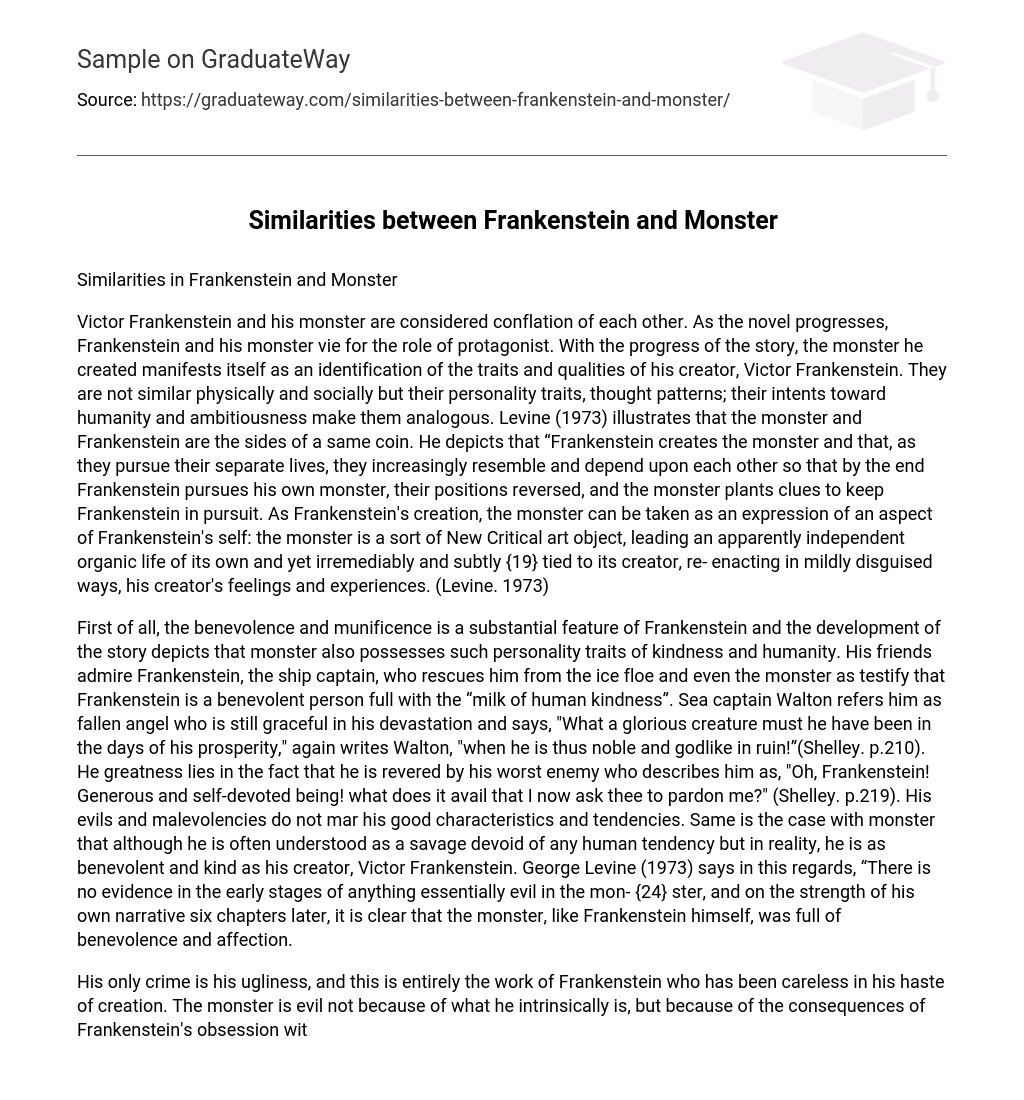Similarities in Frankenstein and Monster
Victor Frankenstein and his monster are considered conflation of each other. As the novel progresses, Frankenstein and his monster vie for the role of protagonist. With the progress of the story, the monster he created manifests itself as an identification of the traits and qualities of his creator, Victor Frankenstein. They are not similar physically and socially but their personality traits, thought patterns; their intents toward humanity and ambitiousness make them analogous. Levine (1973) illustrates that the monster and Frankenstein are the sides of a same coin. He depicts that “Frankenstein creates the monster and that, as they pursue their separate lives, they increasingly resemble and depend upon each other so that by the end Frankenstein pursues his own monster, their positions reversed, and the monster plants clues to keep Frankenstein in pursuit. As Frankenstein’s creation, the monster can be taken as an expression of an aspect of Frankenstein’s self: the monster is a sort of New Critical art object, leading an apparently independent organic life of its own and yet irremediably and subtly {19} tied to its creator, re- enacting in mildly disguised ways, his creator’s feelings and experiences. (Levine. 1973)
First of all, the benevolence and munificence is a substantial feature of Frankenstein and the development of the story depicts that monster also possesses such personality traits of kindness and humanity. His friends admire Frankenstein, the ship captain, who rescues him from the ice floe and even the monster as testify that Frankenstein is a benevolent person full with the “milk of human kindness”. Sea captain Walton refers him as fallen angel who is still graceful in his devastation and says, “What a glorious creature must he have been in the days of his prosperity,” again writes Walton, “when he is thus noble and godlike in ruin!”(Shelley. p.210). He greatness lies in the fact that he is revered by his worst enemy who describes him as, “Oh, Frankenstein! Generous and self-devoted being! what does it avail that I now ask thee to pardon me?” (Shelley. p.219). His evils and malevolencies do not mar his good characteristics and tendencies. Same is the case with monster that although he is often understood as a savage devoid of any human tendency but in reality, he is as benevolent and kind as his creator, Victor Frankenstein. George Levine (1973) says in this regards, “There is no evidence in the early stages of anything essentially evil in the mon- {24} ster, and on the strength of his own narrative six chapters later, it is clear that the monster, like Frankenstein himself, was full of benevolence and affection.
His only crime is his ugliness, and this is entirely the work of Frankenstein who has been careless in his haste of creation. The monster is evil not because of what he intrinsically is, but because of the consequences of Frankenstein’s obsession with creating him. (Levine. 1973) So evil manifested by monster in the later parts of the novels is not innate or inculcated in the very spirit of his personality but it was materialization revenge and a reaction of the pathos and miseries he was afflicted with by humans, for example his unidentified acts of kindheartedness to the cottage-dwellers and saving the life of a child are reimbursed with unsubstantiated abhorrence. But yet gain his intentions to ward human were nobler and full of benevolence. His atrocities toward human are the retorts to the world he inhabits, as opposed to something innate.
Monster, during his reverence of his creator, points out his self-devotion. This self-devotion together with his benevolent aspiration to “banish disease from the human frame and render man invulnerable to any but a violent death” (p. 40) creates a dual nature in him. Although his intents are virtuous but his ambitions capacitates him to go to any extent to get his objective accomplished. However, despite, Frankenstein ensnare himself in a despicable hunt that causes him to devastate his own good being and make his “fellow-creatures as if . . . guilty of a crime” (p. 55). Levine reinforces this ideas in these words that “His vices are the defects of his virtues: it was the desire both for glory and to aid mankind that led him to create the monster.” (Levine, 1973) The monster displays a parallel duality of nature exciting sympathy as well as dismay toward him. He claims our kindness to the degree that we identify ourselves in his existential seclusion.
Monster himself suffers from this duality of nature and had self-devoted cravings together with love and care for human beings. His love for Elizabeth and murder for the purpose to get him is reflection of this ambivalent personality. Monster ambitiousness is similar to Frankenstein. It makes him to learn and devise new ways of expressing himself. The major dilemma of monster is not devotion like Frankenstein but it is self-identification. He educates himself by reading such phrases of Paradise Lost. “Who was I? What was I? Whence did I come?” (p. 125), that generates in him an urge to locate his identity and that becomes the ultimate cause of his tragedy.
By their own accounts, both Frankenstein and the monster start with munificent intentions and turn out to be murderers. The monster may appear more considerate because he is by nature an outsider, whereas Frankenstein intentionally eliminates himself from society. However, in the end, both cease to live with ‘troubled hearts in a troubled society.”
References
Levine, George. Frankenstein and the Tradition of Realism. NOVEL: A Forum on Fiction, 7.1 (Autumn, 1973): 14-30.
Website: http://links.jstor.org/sici?sici=0029-5132(197323)7%3A1%3C14%3A%22ATTOR%3E2.0.CO%3B2-3
Shelley, Mary Wollstonecraft. Mary Wollstonecraft Shelley’s Frankenstein, or, The modern Prometheus. A Longman cultural ed. New York: Longman, 2003.





